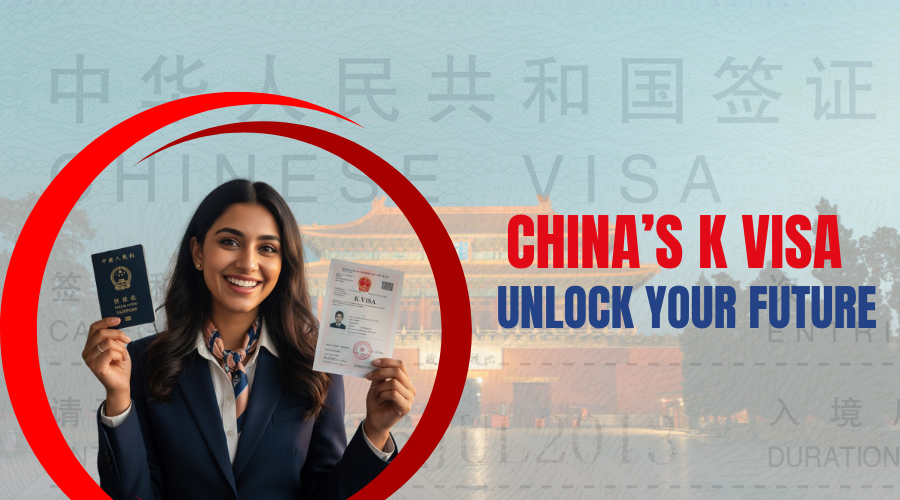In a world where visa rules are getting tougher and competition for global talent is heating up, China has just made a bold move. The country recently launched a brand-new visa category — the K Visa — aimed at attracting young professionals in STEM (Science, Technology, Engineering, and Mathematics) fields.
If you’re a researcher, engineer, or tech innovator dreaming of working in one of the world’s most dynamic economies, this could be the opportunity you’ve been waiting for.
What Is the China K Visa?
The K Visa is a new type of entry permit introduced by the Chinese government under State Council Order No. 814, which officially came into effect on October 1, 2025.
It’s designed specifically to welcome global talent in science and technology, especially young innovators, researchers, and entrepreneurs who want to contribute to China’s growing innovation ecosystem.
In simple terms, you can think of the K Visa as China’s answer to the U.S. H-1B or the UK’s Global Talent Visa, but with more flexibility and fewer barriers.
Who Is Eligible to Apply?
The K Visa targets individuals who have a strong background in STEM.
To qualify:
-
You must hold at least a Bachelor’s degree or higher in Science, Technology, Engineering, or Mathematics.
-
The program primarily focuses on “young professionals” — although an exact age limit hasn’t been announced yet.
-
Most importantly, you don’t need a job offer, sponsor, or invitation letter to apply.
That’s a huge change from traditional work visas, which usually require an employer in the destination country to act as your sponsor. The K Visa lets you apply independently, giving professionals more freedom to explore opportunities across China.
What Can You Do with a K Visa?
The K Visa allows foreign professionals to engage in a wide range of activities related to research, education, and innovation.
Holders can:
-
Teach or conduct research at Chinese universities.
-
Work with tech startups or innovation hubs.
-
Launch or invest in new technology ventures.
-
Participate in cultural or academic exchange programs.
It’s also expected to be a multiple-entry visa, allowing you to travel in and out of China freely during its validity period — something that’s especially helpful for researchers, consultants, or entrepreneurs with international collaborations.
Why China Introduced the K Visa
China’s move is part of a bigger national strategy to attract top-tier global talent.
In recent years, the country has been investing heavily in artificial intelligence, renewable energy, biotechnology, and advanced manufacturing — industries that rely on cutting-edge scientific expertise.
By introducing the K Visa, China aims to:
-
Compete globally for STEM professionals.
-
Encourage innovation and entrepreneurship.
-
Strengthen its position as a global tech leader.
This visa also comes at a time when many Western countries are tightening their immigration policies — making China an increasingly attractive destination for ambitious young professionals.
Key Benefits of the K Visa
Here’s why the K Visa stands out:
-
No sponsor or employer needed you can apply on your own.
-
Flexible stay and multiple entries, making it easy to travel for research or business.
-
Open to freelancers, researchers, and entrepreneurs, not just employees.
-
Opportunities in innovation hubs like Beijing, Shanghai, Shenzhen, and Hangzhou.
It’s a visa designed not just for workers, but for creators and thinkers who want to shape the future of science and technology.
K Visa vs. Other Popular Work Visas
| Visa Type | Country | Requirement | Sponsor Needed | Target Group |
|---|---|---|---|---|
| H-1B Visa | USA | Job offer required | Yes | Skilled workers |
| Global Talent Visa | UK | Endorsement from recognized body | No | Industry leaders |
| K Visa | China | STEM degree | No | Young professionals & researchers |
The table clearly shows how the K Visa provides a middle ground — open like the UK model, but focused specifically on technology and science like the H-1B.
Some Questions Still Remain
As the visa is newly launched, some details are still under review.
Unconfirmed aspects include:
-
The exact age limit for “young professionals.”
-
The duration and renewal process (expected between 1 to 5 years).
-
Whether work authorization is automatically included or requires local registration.
Chinese embassies and consulates are expected to release country-specific details soon, including how to apply, required documents, and processing times.
How to Prepare If You’re Interested
If the K Visa sounds like an opportunity you’d want to explore, here are some steps to get ready:
-
Update your academic and professional documents, including degree certificates and research papers.
-
Prepare a strong resume or research portfolio highlighting your STEM experience.
-
Follow announcements from your local Chinese Embassy or Consulate for official guidelines.
-
Learn basic Mandarin and familiarize yourself with China’s professional culture — it’ll help you adapt faster once you arrive.
Final Thoughts
China’s K Visa marks a new era in the country’s immigration and talent policy. It’s more than just a visa — it’s a statement that China wants to become a global hub for innovation and scientific collaboration.
For young professionals, researchers, and entrepreneurs, this could open doors to incredible opportunities in one of the fastest-growing economies in the world.
So, would you consider applying for the K Visa and starting your journey in China’s innovation landscape?
Share your thoughts in the comments — and stay tuned for more global visa insights like this one.



